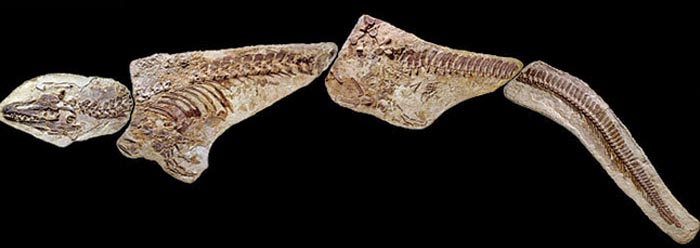Mosasaurs were 40-foot-long marine reptiles with fearsome teeth. Presumed to be extinct, they have been found as fossils on every continent. One unique mosasaur fossil has been housed at the Dinosaur Institute of the Natural History Museum of Los Angeles County for over 40 years. Scientists were able to study not only its bones, but remains of its skin, an eye, and other internal organs from original soft tissues that were preserved. Their study was recently published online in PLoS ONE, and its freely accessible images are spectacular.1
The researchers analyzed purple residue where eyes were once housed in the mosasaur skull. Standard thinking would suggest that some purple mineral had filled in that area during the “80 million years” the fossil was buried in a Kansas chalk formation. But that wasn’t the case. Instead, the presence of microscopic pigment-filled structures called melanosomes, which reduce the scattering of light inside vertebrate eyes, verified that the residue “may represent remnants of the retina.”1 This dark tissue is known to many anatomy students from eyeball dissections, but the idea that fossils have soft parts is known to very few.
This incredible evidence argues so strongly for a recent deposition of this fossil, and flies so squarely in the face of deep-time interpretations, that it is sure to be met with skepticism in the scientific community. Anticipating this, the authors considered whether the dark retinal melanosomes were actually bacteria. They concluded that bacteria would have grown on the outside of the whole fossil, not on the inside and not just in the eye. And the microscopic shapes exactly matched that of melanosomes—not bacteria.
Also found among the “exceptionally preserved soft tissue” were dark red patches in the chest cavity.1 One of the patches was in the same area a dolphin’s heart would be located, and the other was in a likely spot for a liver. Is it possible that these two blood-rich organs did not completely decay? The investigators wanted to discover the chemical responsible for the red color, and the result was spectacular.
Using state-of-the-art equipment, they identified “hemoglobin decomposition products.”1 Hemoglobin is a major chemical constituent of blood. Anyone who has accidentally left meat out of the refrigerator overnight knows that it decomposes quickly. After death, hemoglobin proteins always fall apart, even when sterilized and with no water, spontaneously converting into smaller, simpler molecules.
The authors did not address the glaring question of why there was dried blood residue in a fossil dated as millions of years old. The reason is simple—they have no idea why!
In addition to the amazingly rare retinal and still-red partly decomposed blood tissues, the researchers stated that “the most remarkable features of [this fossil] are the preservation of skin structures from all parts of the body.”1 They described in detail the different skin scale sizes and shapes present from head to tail.
So, considering the “wide range of soft tissue structures”1 in this and other fossils of supposed antiquity, and considering that “all of the chemistry, and all of the molecular breakdown experiments that [scientists have] done don’t allow for this,”2 it appears that a vast ages interpretation of this and similar fossils is in error.3
The persistence of retinal remains, blood residue, and skin scales only makes sense if the remains were deposited sometime in the near past. This fossil and the sedimentary rock that housed it point clearly to the recent and overwhelmingly powerful Flood of Noah.
References
- Lindgren J. et al. 2010. Convergent Evolution in Aquatic Tetrapods: Insights from an Exceptional Fossil Mosasaur. PLoS ONE. 5 (8): e11998.
- Schweitzer, M. That Dinosaur Discovery. Interview on MSNBC. Available on youtube.com under “Scientific World Reeling from New Discovery of T-rex Bone Cells and Soft Tissue.”
- Descriptions of some recently discovered soft-tissue fossils are available in the articles listed at icr.org/fresh-fossils.
Image credit: Copyright: © 2010 Lindgren et al, PloS ONE 5 (8): e11998
* Mr. Thomas is Science Writer at the Institute for Creation Research.
Cite this article: Thomas, B. 2010. Extraordinary Mosasaur Fossil Reveals Original Soft Tissues. Acts & Facts. 39 (11): 19.










